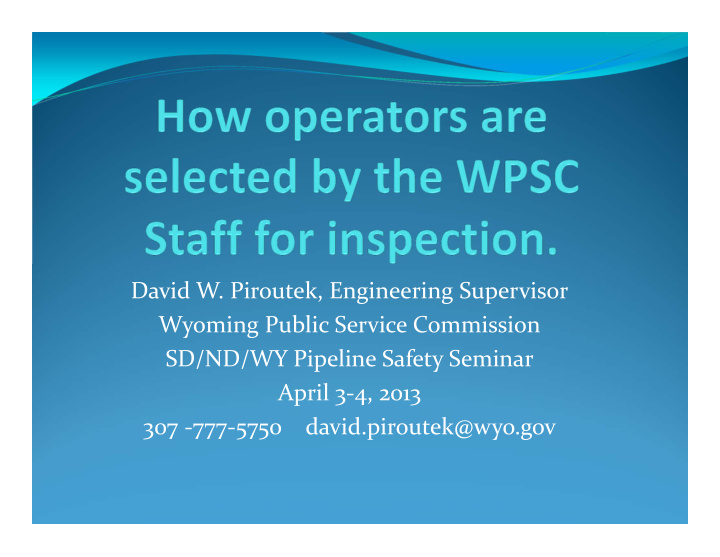



David W. Piroutek, Engineering Supervisor Wyoming Public Service Commission SD/ND/WY Pipeline Safety Seminar April 3 ‐ 4, 2013 307 ‐ 777 ‐ 5750 david.piroutek@wyo.gov
First Choice � The Wyoming Public Service Commission makes every effort to inspect every operator every year.
Reasons First Choice can not be met. � Shortage of qualified inspectors � Major construction projects happening during the year � Major incidents which require additional inspection time. � Other circumstances
Basis for determining who will be inspected, when first choice does not work. � Length of time since last inspection � Past performance on inspections � Miles of transmission/main/services � Population density � Reported leaks per mile/service � Past incidents
Types of inspections � Program Inspections ‐ Transmission Integrity management, Distribution Integrity Management, Control Room Management, Headquarters Operator Qualification, Public Awareness and Headquarters Drug and Alcohol � Field/Follow ‐ up – Shorter versions of the Program inspections to determine if operator is following program procedures. � Standard Inspections – The standard transmission and distribution inspections.
Maximum Time between Inspections � Program inspections ‐ 5 years � Field/Follow ‐ up – 2 to 3 years after program inspection. � Standard Inspections – 3 years for field and records, 5 years for procedures. � LNG – Annually � Construction as frequently as determined by the Engineering Supervisor and the Commission Administrator. � Follow ‐ up inspections – as necessary to close citations.
Length of time since last inspection � Attempt to inspect every operator every year in one form or another. � Maximum 3 years between inspections.
Past Performance on inspections � If we are finding issues during past inspections you will be inspected more frequently. � If we are not finding issues during inspections than you will not be inspected as frequently.
Miles of transmission/main/number of services. � The more miles of transmission and mains and number of services will cause for an increase in the inspection units to be assigned to an operator and the more frequently we will inspect them.
Population Density � The greater the population within the service territory the more often we will be inspecting the area.
Reported Leaks per mile/service � The more leaks per mile of main or transmission or the more leaks per service the more often we will inspect the operator.
Past incidents � An operator has a history of incidents we will inspect them more often.
Determining who and where we will inspect. � When we are not able to inspect every operator and every inspection unit the above factors will be weighted to determine the inspection schedule. � The higher the risk ranking the greater the chance of being inspected.
Any Questions?
Recommend
More recommend